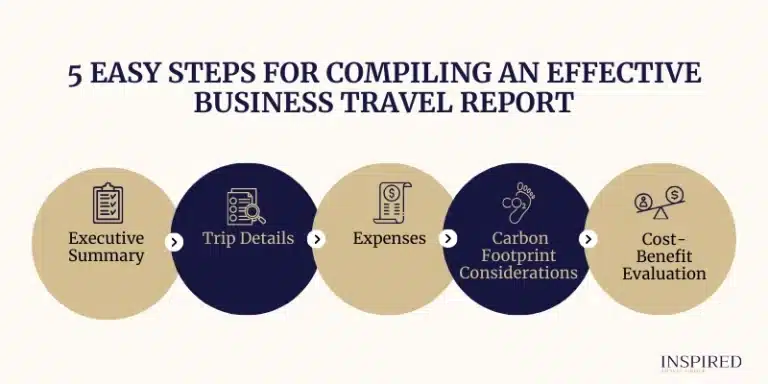
Inspired Travel Group is a full-service corporate travel agency servicing clients right the way across North America. Our people first approach to travel ensures only the highest levels of personalized, attentive service.
Business travel is an essential part of many organizations, allowing for direct networking, client meetings and new opportunities that aren’t possible through digital means alone. However, the aftermath of a business trip often involves the less exciting task of compiling a travel report. Here’s how to create an informative and comprehensive business travel report in 5 easy steps.

The executive summary serves as the report’s introduction, offering a snapshot of the trip’s purpose, destination, duration and attendees. For instance, the purpose could range from attending an international trade conference to meeting key partners. Clearly state the location of your travel, the length of your stay and list all company representatives who attended. A template might start with, “From [Start Date] to [End Date], [Attendee Names] traveled to [Destination] for [Purpose].” This section sets the stage for the detailed account that follows and helps stakeholders quickly grasp the trip’s scope and significance.
Detailing the trip involves documenting every aspect of the journey. Start with flights: Include flight numbers, times and any delays encountered. Next, describe the meetings attended, including the objectives, who was present and the outcomes. Also, include any events or ancillary activities, highlighting how each was relevant to your business objectives.
To streamline this process, consider using itinerary management tools like TripIt or Concur, which can automatically compile flight schedules, hotel bookings and meeting appointments in one place.
An accurate record of all expenses incurred is crucial for budgeting and reimbursement purposes. Categorize expenses by type—such as accommodation, meals, transportation and incidentals—and compare these against the planned budget. Keeping and organizing receipts is vital. Digital expense reporting tools like Expensify or SAP Concur can significantly simplify this task by tracking spending in real-time and ensuring policy compliance.
Understanding the environmental impact of business travel is essential. This section should evaluate the carbon footprint, considering factors like aircraft type and travel distance. Discuss the measures taken to minimize environmental impact, such as choosing direct flights or participating in carbon offset programs.
Calculators from the International Civil Aviation Organization (ICAO) or MyClimate can help estimate your travel’s carbon emissions, providing a basis for offsetting efforts and future planning to reduce the environmental impact.
Evaluate whether the travel was worth it. Did the benefits—such as new contracts, partnerships or insights—justify the cost? This critical analysis helps in refining future travel policies and practices, ensuring that each trip is not only productive but also cost-effective.
Compiling a detailed business travel report might appear challenging at first. But, it does serve as an important service for helping monitor expenditures and evaluate the effectiveness of a trip. By following these five steps, you can create a report that not only satisfies corporate requirements but also contributes to more mindful and effective travel planning in the future.
To further streamline your business travel experiences, consider partnering with Inspired Travel Group, your go-to Corporate Travel Agency. We’re dedicated to handling every aspect of your journey, ensuring a seamless and successful experience from start to finish. Contact us today to address all your corporate travel needs and transform every trip into an unforgettable journey.